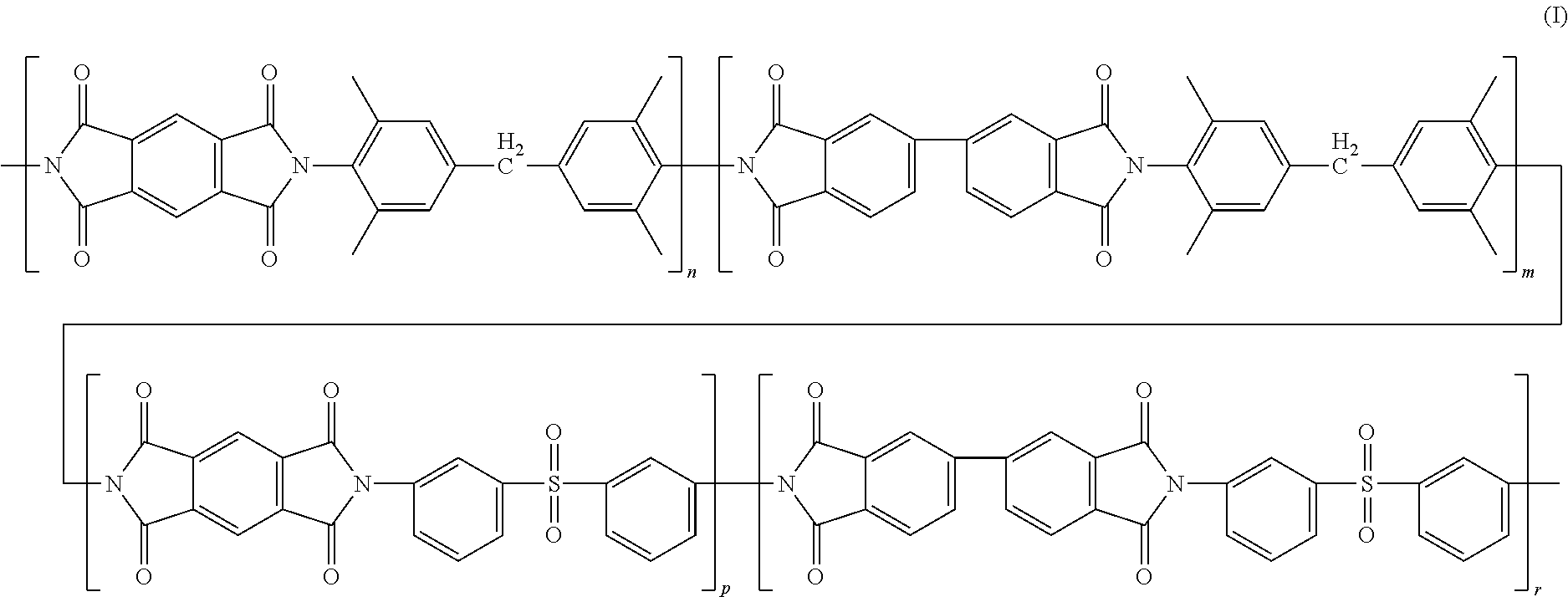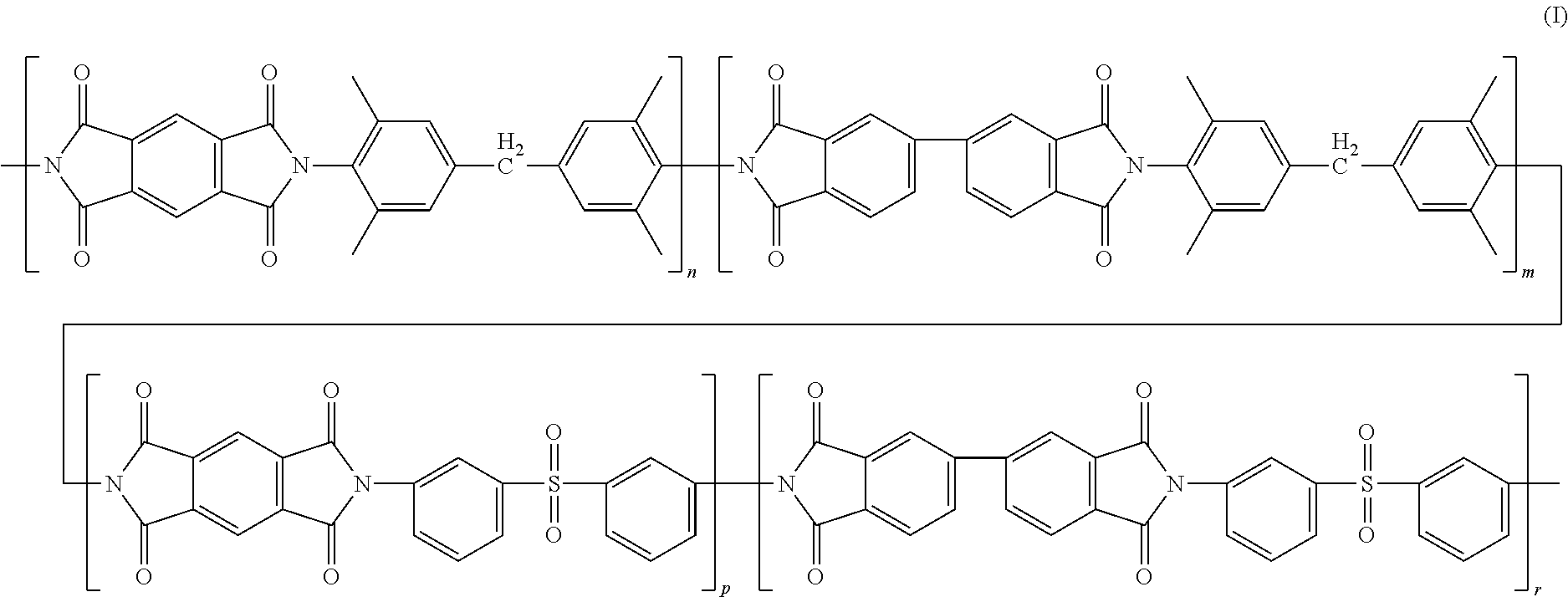High permeance membranes for gas separations
a gas separation membrane, high permeance technology, applied in the field of new high permeance copolyimide membranes, can solve the problems of reducing membrane selectivity, reducing the selectivity of membranes, and difficult fabrication of defect-free high selectivity asymmetric integral skinned gas separation membranes, etc., to achieve the effect of improving selectivity and high co2 permeability
- Summary
- Abstract
- Description
- Claims
- Application Information
AI Technical Summary
Benefits of technology
Problems solved by technology
Method used
Image
Examples
example 1
Preparation and Evaluation of Poly(PMDA-BPDA-TMMDA-3,3′-DDS-3-1-3-1) Copolyimide Dense Film Membrane from Poly(PMDA-BPDA-TMMDA-3,3′-DDS-3-1-3-1) Random Copolyimide
[0036]10.0 g of poly(PMDA-BPDA-TMMDA-3,3′-DDS-3-1-3-1) random copolyimide synthesized from polycondensation reaction of PMDA and BPDA with TMMDA and 3,3′-DDS (PMDA / BPDA=3:1 and TMMDA / 3,3′-DDS=3:1 molar ratio) was dissolved in 40.0 g of NMP. The mixture was mechanically stirred for 2 hours to form a homogeneous casting dope. The resulting homogeneous casting dope was allowed to degas overnight. The poly(PMDA-BPDA-TMMDA-3,3′-DDS-3-1-3-1) copolyimide dense film membrane was prepared from the bubble free casting dope on a clean glass plate using a doctor knife with a 18-mil gap. The dense film membrane together with the glass plate was then put into a vacuum oven. The solvents were removed by slowly increasing the vacuum and the temperature of the vacuum oven. Finally, the dense film membrane was heated at 200° C. under vacuum...
example 2
Preparation of Poly(PMDA-BPDA-TMMDA-3,3′-DDS-3-1-3-1) Asymmetric Hollow Fiber Membrane
[0038]A poly(PMDA-BPDA-TMMDA-3,3′-DDS-3-1-3-1) asymmetric hollow fiber membrane was prepared from a spinning dope comprising 20.5 g of poly(PMDA-BPDA-TMMDA-3,3′-DDS-3-1-3-1), 2.5 g of 1,3-dioxolane and 66.3 g of NMP. The poly(PMDA-BPDA-TMMDA-3,3′-DDS-3-1-3-1) spinning dope was extruded from the annulus of a hollow fiber membrane spinneret at a flow rate of 3.0 mL / min. At the same time, a bore solution of 10 wt % H2O / 90 wt % NMP flowed from the inner passage of the spinneret at 0.6 mL / min to keep the nascent fiber from collapsing. During extrusion, the dope and spinneret were controlled at 50° C. The nascent fiber passed through an air gap of 10 cm and then entered a water coagulation bath at approximately 0° C. Finally, the solidified hollow fiber membrane was wound on a take-up drum partially submersed in room temperature water at 23.5 m / min. The newly formed hollow fibers from each set of membran...
example 3
Preparation of Epoxysilicone-Coated and UV Cross-Linked Poly(PMDA-BPDA-TMMDA-3,3′-DDS-3-1-3-1) Asymmetric Hollow Fiber Membrane
[0039]Poly(PMDA-BPDA-TMMDA-3,3′-DDS-3-1-3-1) asymmetric hollow fibers prepared in Example 2 were dip-coated with a 5 wt % of epoxysilicone solution in a mixture of heptane and hexane solvents and UV treated for 2.5 min. Ten of the epoxysilicone-coated and UV cross-linked poly(PMDA-BPDA-TMMDA-3,3′-DDS-3-1-3-1) asymmetric hollow fibers were bundled together and sealed into a stainless steel module for gas permeation testing.
PUM
| Property | Measurement | Unit |
|---|---|---|
| Permeability | aaaaa | aaaaa |
| Molar ratio | aaaaa | aaaaa |
| Exposure limit | aaaaa | aaaaa |
Abstract
Description
Claims
Application Information
 Login to View More
Login to View More - R&D
- Intellectual Property
- Life Sciences
- Materials
- Tech Scout
- Unparalleled Data Quality
- Higher Quality Content
- 60% Fewer Hallucinations
Browse by: Latest US Patents, China's latest patents, Technical Efficacy Thesaurus, Application Domain, Technology Topic, Popular Technical Reports.
© 2025 PatSnap. All rights reserved.Legal|Privacy policy|Modern Slavery Act Transparency Statement|Sitemap|About US| Contact US: help@patsnap.com



